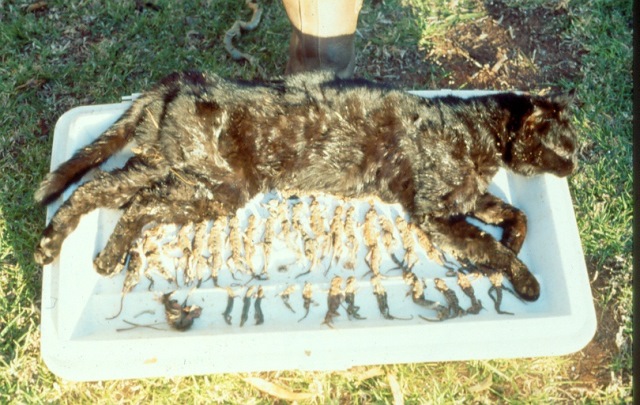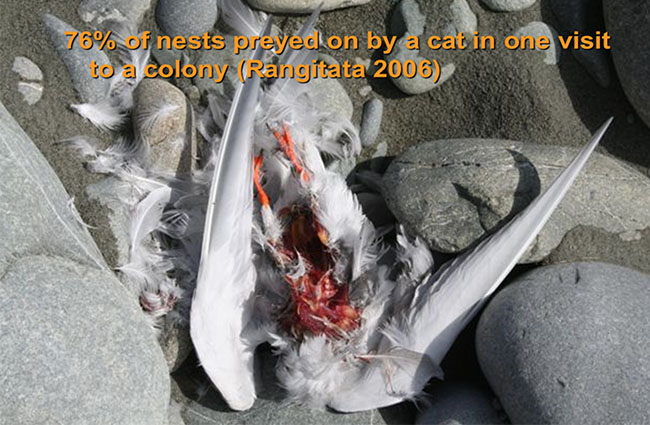Cats:
Description
Domestic, feral, wild, or stray cats are the same species (Felus catus). Introduced into New Zealand by European settlers in the mid 19th century, in 2011 there were are an estimated 1.419 million domestic cats in New Zealand. An unknown but significant number have become wild or feral, being highly successful top-level predators. It has only been relatively recently that the impact of cats on wildlife has become better understood.
Feral cats live independently of humans and breed in the wild, although they also breed with unwanted domestic cats.

Where are they found?
Along all braided river ecosystems in New Zealand.
Why are they a problem?

- Opportunistic hunters of endemic birds, reptiles, and invertebrates, as well as introduced pest mammals including rats, mice, and rabbits
- No matter how well fed, a cat’s natural instinct is to hunt
- The presence of cats on braided rivers can lead birds to abandon nests and chicks
- Cat ownership per person in New Zealand is one of the highest in the world, leading to an emotive argument that favours cats over rare and endangered native wildlife
- The SPCA’s policy of ‘trap-neuter-return’ returns undomesticated cats to the wild colonies. As these colonies also uptake abandoned un-neutered cats, the policy does not reduce cat numbers or commensurate bird kill rates. This single neutered male cat wiped an entire colony of fairy terns, in spite of the colony being inside a protected sanctuary
- Feral cats are estimated to be responsible for the extinction of 6 endemic bird species and over 70 localised subspecies, as well as depleting the populations of bird and lizard species
- Studies in the US show that up to 4 billion (not a misprint) birds are killed annually in that country alone by cats
Conservation activities
When other pest mammals such as rats, mice, and rabbits are controlled, cats specifically target birds, lizards, and larger invertebrates. When rabbit haemorrhagic disease (RCD) was illegally introduced into New Zealand, feral cats switched from preying on rabbits to preying on native fauna, including the black stilt, leading DOC to undergo a trapping programme for cats and other predators.
- Cat traps are used on several braided rivers during the breeding season
Information for cat owner/lovers
- Don’t feed stray cats. This is misplaced sympathy. A well-fed stray, feral, or wild cat –has more energy to hunt native species, will breed more successfully, and carries multiple diseases known to infect your cat and humans
If you own a cat:
- Have your cat neutered or spayed so they can’t produce unwanted kittens
- Keep your cat well fed and have moving toys for it to play with, so it is less inclined to chase birds, etc
- Keep your cat indoors during the day. Otago University research has shown that in New Zealand, domestic cats prefer to hunt birds during the mornings, lizards in the afternoons, and rats and mice at night. However, near braided rivers, domestic cats have been filmed stalking braided river bird chicks at night. One domestic cat can result in an entire colony of breeding birds abandoning a nesting site.
- Don’t dump unwanted kittens and cats – either give them to the SPCA or ask a vet to put them down humanely
- Collaring you cats with bells will reduce their kill rate by 50%
- Microchip your cat to ensure it is not inadvertently destroyed if caught in a live trap
- Consider replacing it with a different type of pet when it dies
More information & research
- 2016: Seddon; GPS tracking of cats in riverbeds (BRaid seminar)
- 2013: Loss et al; The impact of free-ranging domestic cats on wildlife of the United States Nature doi:10.1038/ncomms2380
- 2009: Peterson et al; Opinions from the Front Lines of Cat Colony Management Conflict PLOS doi: 10.1371/journal.pone.0044616
- 2009: Driscoll et al; From wild animals to domestic pets, an evolutionary view of domestication PNAS (open access PDF)
- Native birds better protected when cats wear bell collars (Otago University)
- Cat fact sheet (Forest & Bird)
- Pest Detective: Cats
- See Predators/research and references
- See Ecology/research and references
